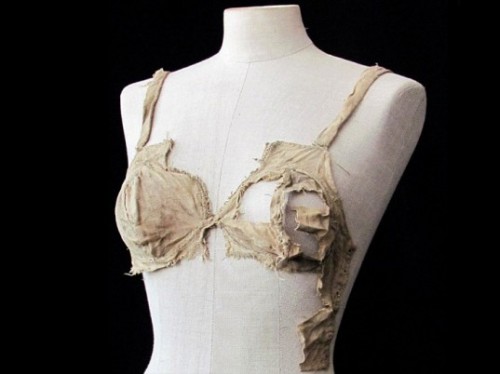lissabryan: These have been popping up on social media sites again recently. No, this i
lissabryan: These have been popping up on social media sites again recently. No, this is not a medieval “bra,” nor is the lower picture an image of a pair of “panties.” The first garment is more like a “pair of bodies” or a camisole. It once had panels that went around the torso and laced down the sides. You can see some of the eyelets running down the side on the right. The cups are simply all that survived of the garment. There may have also been a panel of cloth between the cups that’s now missing, judging from the shredded cloth around the top edges. Because the top edge of the garment may have been visible, it could have been silk, or another fine material. Silk crumbles to dust over the centuries, especially if its dyes have inherent vice. It may have had boning, stiffening, or stays in the front panel at one point, but they were probably eaten by pests. We’re looking at an incomplete garment that happens to look somewhat like a modern bra in its shredded form, but that’s not what it was back then. It’s a remarkable find, because if I recall, it’s the only one they’ve ever discovered with defined cups for each breast, though references to them are found in poetry of the era. The garment in the bottom picture is probably a menstrual garment, if it belonged to a female, not a pair of bikini underpants as it’s being called online. Menstrual undergarments of the era held disposable padding in place, but the garment itself had several layers of cloth to prevent any leaks. (Further proof it wasn’t a “pair of panties.” Few women want heavy, multi-layer cloth padding in their underpants.) Think of it as being along the lines of menstrual belts of the 1950s. I’ve seen this touted as “proof” that women wore underpants in the 16th century. The modern temptation is to think that OF COURSE they would have wanted underpants - because we, modern women who’ve grown up wearing them, want underpants - but women of the 16th century probably would have thought of the notion as kind of distasteful. “Why are you wearing a diaper or menstrual garment all the time?” A romance novel hero flipping up the skirts of his beloved to find such a garment would have probably immediately been entirely put off the notion of engaging with her further. I suppose if someone had wanted to wear underpants, they could have constructed some, but it doesn’t seem to have been a popular choice. Wills and household inventories mentioned every scrap of clothing, down to handkerchiefs and stockings, that a person owned. If underpants had been part of a woman’s clothing set on a frequent basis, they would have shown up in those inventories along with the other undergarments that were listed. (The Tudors didn’t have any silly notions of modesty along those lines. They would have noted them as being present if they were.) Secondly, anyone who’s ever worn a period gown to a reenactment knows how difficult those skirts can be to manage when answering the call of nature, even in spacious modern bathrooms. That’s why in the 19th century, when underwear became popular for women because of hoop skirts, drawers were slit down the middle so a woman could urinate without having to remove them. This little bikini garment would have had to be untied and removed in order to go to the bathroom, and then replaced while trying to juggle an armful of skirts. It’s just impractical to wear all the time. From what I’ve read by the university that discovered the garments, it was associated with a male codpiece, but I wasn’t clear on if it was closely associated, or just found in the same general bundle. So, it could be the garment that a man would wear between the separate legs of his hose. This is a bit before the huge, exaggerated codpieces of Henry VIII’s time, and they were more along the lines of “modesty covers” in that era. -- source link
Tumblr Blog : lissabryan.tumblr.com
#thank you#correction#history#clothing#undergarments#medieval

